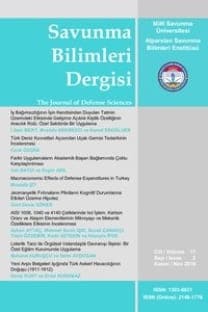Kırsal bölgelerde askeri birliklerin konuşlandırılmasında yer seçimi modellerinin kullanılması
Askeri birliklerin, silah sistemlerinin ve tesislerin konuşlandırılmasına yönelik kararların verilmesinde yer seçimi modellerinden faydalanılabilir. Bu modeller genel olarak coğrafi bir jedeki aday noktalardan, tanımlanan amaca göre en fazla faydayı sağlayanların belirlenmesinde kullanılır. Bu çalışmada kırsal bir bölgede terörle mücadele ile görevlendirilen askeri birliklerin konuşlandırılacağı yerlerin belirlenmesinde yer seçimi modellerinin (Location fodels) kullanılması incelenmiştir. Yer seçimi problemlerine yönelik oldukça çeşitli formülasyon ve çözüm algoritması söz konusu olmakla birlikte, bu çalışmada ağ tipi modeller üzerinde durularak p-medyan, p-merkez, küme kaplama (set covering) ve maksimum kaplama problemleri ele alınmıştır. Örnek senaryolar tanımlanarak çeşitli amaçlar ve kısıtlamalara göre matematiksel modeller oluşturulmuş ve bilgisayar yardımı ile optimal çözümler elde edilmiştir. Çözümlerin değerlendirilmesiyapılarakbölgedekikritiknoktalar belirlenmişveayrıcaönemli paremetrelerdeki değişikliklerin çözüme olan etkisi de incelenmiştir.
The use of location models for the deployment of military troops in rural regions
Location models can be used in decision processes regarding the deployment of military troops, apon systems and facilities. These models are generally used in determining among all [candidate points within a region the ones providing the maximum benefit in terms of the (objective. This study examines the use of location models in deciding the positions that military sops will be deployed in a rural environment Although there are a wide variety of formulations nd solution algorithms concerning location models, taking into consideration network type iels p-median, p-center, set covering and maximum covering problems are handled in this ndy. After defining some scenarios, mathematical models are developed according to various bjectives and constraints and optimal solutions are obtained using computers. Evaluating the olutions critical points are identified within the region and the effects of changes in major parameters on the solutions is examined as well.
___
- Aikens, C.H., 1985. Facility Location Models for Distribution System Design. European Journal of Operational Research, 162(1): 4-29.
- Brandeau, M.L. ve Chiu, S.S., 1989. An overview of representative problems in location research. Management Science, 35(6):645-674.
- Church, R.L ve ReVelle, C.S., 1974. The Maximal Covering Location Problem. Papers of The Regional Science Association, 32:101-118.
- Curtin, K.M., Hayslett-McCall, K., Qui, F., 2007. Determining Optimal Police Patrol Areas with Maximal Covering and Backup Covering Models. Networks and Spatial Economics, http://www.gmu.edu/departments/ geog/People/Curtin/NETSOnlineFirst.pdf (Erişim tarihi: 03 Mayıs 2008).
- Drezner, Z. ve Wesolowsky, G. O., 1995. Location on a One-way Rectilinear Grid. Journal of the Operational Research Society, 46(6)735-746.
- Hakimi, S.L., 1964. Optimum Locations of Switching Centers and the Absolute Centers and Medians of a Graph. Operations Research, 12:450-459.
- Klose, A. ve Drexl, A., 2005. Facility Location Models for Distribution System Design. European Journal of Operational Research, 162(1): 4-29.
- Neebe, A. W., 1988. A Procedure for Locating Emergency-Service Facilities for All Possible Response Distances. Journal of the Operational Research Society, 39(8)743-748.
- Richard, D., Beguin, H. ve Peeters, D., 1990. The Location of Fire Stations in a Rural Environment: a Case Study. Environment and Planning A, 22:39-52.
- Schilling, D., Jayaraman, V. ve Barkhi, R., 1993. A Review of Covering Problems in Facility Location. Location Science, 1:25-55.
- Trietsh, D., 1993. Optimal Multifacility Defensive Location on Planes with Rectilinear Distances. Networks, 23:517-523.
- ISSN: 1303-6831
- Yayın Aralığı: Yılda 2 Sayı
- Başlangıç: 2002
- Yayıncı: Milli Savunma Üniversitesi Alparslan Savunma Bilimleri ve Millî Güvenlik Enstitüsü
Sayıdaki Diğer Makaleler
Stratejik Bir Bölgede Deniz Gücüne Ait Sahil Gözetleme Radarlarının Yeniden Yerleştirilmesi
Exploring the effects of outsourcing incentives on military logistics outsourcing intention
Örgüt-çevre ilşkisinde uyum-seçim sorunsalına bütünleştirici bir yaklaşım: Birlikte evrim
Ali KARAGÜLMEZ, Tuğçe Elif KURTOĞLU
Nurullah BOZKAYA, Güvenç ARSLAN
Güvenç ARSLAN, Nurullah BOZKAYA
Eğik Basamak Üzerinden Laminer Akışın Sayısal İncelenmesi
Örgüt-Çevre İlişkisinde Uyum-Seçim Sorunsalına Bütünleştirici Bir Yaklaşım: Birlikte Evrim
